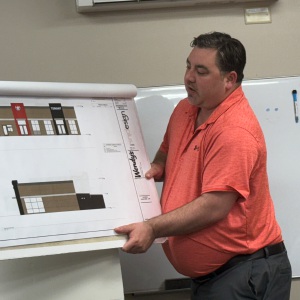The Greenfield Beat: Jesseca Timmons – Museum tells the history of Oak Park
| Published: 08-16-2024 8:28 AM |
Greenfield is fortunate to have an active historical society, with its own museum and barn on Forest Road. Lenny Cornwell, who was the longtime president and has organized most of the archives in the museum, knows pretty much everything there is to know about the history of Greenfield, including the long history of Oak Park.
During his many years at GHS, Lenny maintained files with hundreds of documents showing the history of Oak Park, and is still adding to the Oak Park file today, right up to the design feedback session that took place a few weeks ago. A huge thanks to Lenny for sharing what he has learned about Oak Park!
Anyone stopping by Oak Park today might see children in the playground, a few dogs being walked and people exercising on the track. On weekends in the summer months, the park hosts the Greenfield Farmers’ and Crafters’ Market, baseball games, events such as the Drawbar and Harness Club tractor show and more recently, Fourth of July festivities. It is hard to imagine that 100 years ago, during the annual Oak Park Fair, the same track where people exercise today would have been lined with thousands of people packed into grandstands and screaming as horses raced by.
In 1875, the land which is now Oak Park was owned by a Mr. Dunklee, who agreed to lease the land to the Oak Park Fair Association for five years. The Oak Park Fair Association, founded by a group of town residents, sold shares for $5 apiece. The fair flourished from 1875 to 1886, but by 1894, the organization had folded and the fairground buildings were removed.
In 1899, another group of residents in town, including George Holt and Etna Fletcher, created the New Oak Park Fair Association, bought the land from Mr. Duncklee and sold shares in the organization for $25. The new fair was a huge success. Old photos and articles indicate there midway attractions, vendors, exhibits and entertainment, including “vaudeville.” It became so popular over the years that the B & M railroad in Fitchburg, Mass., sold special “Oak Park Fair” tickets. Nashua merchants advertised especially for the fair weekend, as the event drew people from all over New England.
According to Lenny’s research, in 1899, the New Oak Park association built a large hall called Floral Hall, cattle pens that were 400 feet long and refurbished the horse track for races. Farmers displayed their prize animals and produce, and their wives would compete with handiwork, including craft work, sewing and baked and canned items.
Though the 1800s and early 1900s, Greenfield was a popular tourist destination. Visitors came by train to stay for several weeks in Greenfield’s boarding houses and hotels to enjoy the town’s lakes and mountains. Visitors who wanted to continue on to Francestown took a stagecoach, which today, is beautifully maintained in the collection at the Francestown Historical Society.
Tourists could also take advantage of special train fares from Greenfield to Keene, Old Orchard Beach in Maine, Lake Sunapee and other destinations. Another big tourist draw in town was Otter Lake Park, which later became Camp Union, and is now the Barbara C. Harris center – but that is a story for another day.
Article continues after...
Yesterday's Most Read Articles
 Wendy’s looks to add location on Route 119 in Rindge
Wendy’s looks to add location on Route 119 in Rindge
 U.S. Rep. Maggie Goodlander buys home in Concord, in NH’s second district
U.S. Rep. Maggie Goodlander buys home in Concord, in NH’s second district
 Groundbreaking celebrates start of construction at new Peterborough fire station
Groundbreaking celebrates start of construction at new Peterborough fire station
 Blindfold Boat Race returns to Norway Pond in Hancock June 9
Blindfold Boat Race returns to Norway Pond in Hancock June 9
 Damien Cronan will be recognized at ConVal graduation
Damien Cronan will be recognized at ConVal graduation
The New Oak Park Fair Association held fairs until 1915. A third group, the Hillsborough County Fair Association (which is not associated with the existing Hillsborough County Agricultural Association) held fairs until 1925.
In 1923, Lenny’s uncle, Harold Eastman, rode as a jockey in a race at Oak Park, in the employment of a Peterborough family. After 1925, ownership of the park fell to the Guyette family, and, as I wrote previously, Oak Park fell dormant, and was not used for much more than baseball for about 60 years, when it was purchased by the town.
If you have an idea for the Greenfield Beat, please send email to JessecaTimmons at jtimmons@ledgertranscript.com.


















 STAYCATION: Learn about local summer activities
STAYCATION: Learn about local summer activities Learn about this year’s legislative session
Learn about this year’s legislative session
